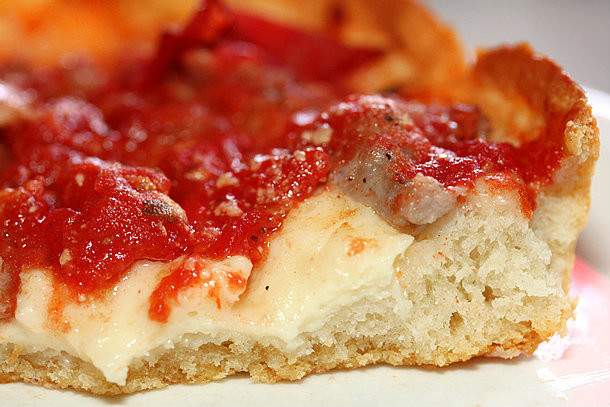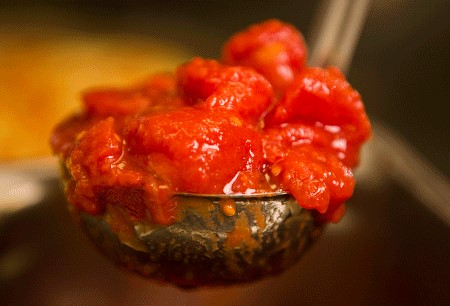Images courtesy of Malnati's Pizzeria, Chicago IL.
The most famous of thing to come out of Chicago beside bootlegging and Al Capone is deep-dish pizza!
The term deep dish refers to the pan in which the pizza is made, usually 2" deep giving the finished pizza its characteristic highsides.
Deep-dish pizza is baked in a round, steel pan that is more like a pie than a typical pizza and the buttered pan creates a fried effect on the outside of the crust.
The Chicago deep dish has layers of meat or vegetables with tomato sauce, dense mozzarella and finally, a buttery cracker-like crust.
A cake pan is buttered and the dough is pressed against the deep pan’s round bottom and edges.
The butter slightly fries the dough during the baking process and gives it a distinct golden crunch.
Deep Dish Pizza is a delicious and simple meal that can feed an army and the Duluth Forge Kamado Grill is a perfect vehicle for cooking deep dish pizza as the heat reflects off the dome of the grill onto the pizza and produces a texture in the crust unlike foods cooked in an ordinary oven.
The deep dish pizza is constructed with the tomato sauce on top so the pizza can be cooked for longer at a higher heat and the cheese won't burn.
Chicagoland
Neapolitan immigrants arrived in Chicago at the turn of the century in search of factory jobs and brought a hunger for their native pizza.
By 1920 approximately 60,000 Italian immigrants, the third largest population in the U.S., called Chicago "home."
Pizza was the perfect meal for Italian laborers and many iconic food shops grew around the culture, like Gonella's bakery, Al's Italian Beef, Turano Bakery, and Pizzeria Napolitano.
The Chicago deep-dish pizza was the result of the economy of World War II because the ingredients necessary for pizza dough, flour, oil, salt, and yeast were not rationed and the filling was made from leftovers.
The Malnati Chicago Classic
Everyone has a Pizzeria Uno in their local strip mall but according to a 1956 article from the Chicago Daily News, it was Uno's original pizza chef, Adolpho "Rudy" Malnati, who developed the recipe.
Malnati’s Pizzeria was quick to find success, and has sprouted locations throughout Chicago and its suburbs. The pizza is noticeably less dense than Pizzeria Uno’s with lighter cheese and tangier tomatoes.
It's filled just below the crust’s top edge, leaving more room for the buttercrust. Yes, that's right...butter. Malnati created a very thick butter crust pizza that resembled a pie more than a flatbread and went on to open his own restaurant, Malnati's Pizzeria in 1971.
Traditionally the deep-dish pizza is a thin crust of dough laid in a seasoned cake pan and the ingredients are assembled "upside-down" from the usual order on a pizza. The first ingredient, mozzarella cheese, is placed directly on the dough, and then the rest of the ingredients are placed on top.
The pizza is topped with a tomato sauce made with raw whole chunks of tomatoes. The thick layer of toppings used in deep-dish pizza needs a longer baking time, which could burn cheese or other toppings if they were used as the top layer of the pizza.
The Malnati Chicago Classic in a Kamado Grill
Recipe courtesy Marc Malnati, Malnati's Pizzeria, Chicago, Illinois
Ingredients
Pizza Dough:
- 16 ounces water
- 1/8-ounce yeast
- 1/2-ounce salt
- 2 pounds bread flour
- 1/4 melted butter for Buttercrust
Toppings:
- 2 cups tomato sauce, jar or homemade
- 2 cups shredded mozzarella
- 1/2 cup spinach, shredded
- 1/2 cup grated Romano
- 1/2 cup Hot Italian sausage
- 1/2 cup grated Parmesan
Directions
1. In a mixer combine the water and the yeast and allow the yeast to dissolve.
2. Add the remaining ingredients except for the cornmeal and begin to mix the dough using a dough hook on low speed.
3. Once a ball is formed mix on medium speed for 1 to 2 minutes until the dough becomes elastic and smooth.
4. Remove from the mixer and place in a bowl coated with butter. Allow the dough to rest for approximately 4 hours.
5. Once the dough is rested, place on flat surface and dust with some flour.
6. Preheat Duluth Forge Kamado Grill to 425 degrees F.
7. In a deep baking dish or deep dish pizza pan, spread the dough using your fingers at the bottom of the pan and make sure to have enough dough to come up the sides of the pan approximately 1/2-inch high.
8. Begin by placing a layer of the mozzarella cheese on the bottom of the crust.
9. Add the tomato sauce and all of the toppings.
10. Place in the heated Kamado Grill for 20-25 minutes until golden and crispy.
Allow Deep Dish Pizza to sit for 10-15 minutes letting the juices and cheese to firm up slightly before slicing.
Duluth Forge Ceramic Charcoal Kamado Grill and Smoker - Extra Large Model
$799.99
Introducing the new Extra Large 24 Inch Duluth Forge Charcoal Kamado Ceramic Egg. Whether you are grilling, searing, or smoking meats or fish, the Duluth Forge Kamado Built-In Charcoal Grill is an ideal product for all your outdoor cooking needs.
Created with high-quality ceramic and commercial-grade stainless steel bands, hinges, springs, and hardware make it more resistant to rust. The one inch thick ceramic walls along with large fire bowl allow for better heat retention and even heat circulation. A kamado is a traditional ceramic Japanese wood or charcoal fueled cooking stove.
The ceramic construction for kamado's means there is no flavor contamination or metallic taste given to the food. Kamado's use lump wood charcoal which creates very little ash which can taint food and is manufactured in an environmentally sustainable manner. Regular charcoal briquettes contain many chemicals that contaminate the flavor of the food.
The round shape gives the best heat distribution, unlike rectangular grills which can create hot and cold spots. The heat retention properties of the ceramic shell can reach up to 900 degrees F!
The Duluth Forge Ceramic Charcoal Kamado Grill and Smoker are made from the same materials used to make kilns and pizza ovens which are extremely good insulators that radiate heat effectively. The sides and domes absorb heat and radiate it back like a brick oven, so pizza cooks evenly from above.
 Loading... Please wait...
Loading... Please wait...
















